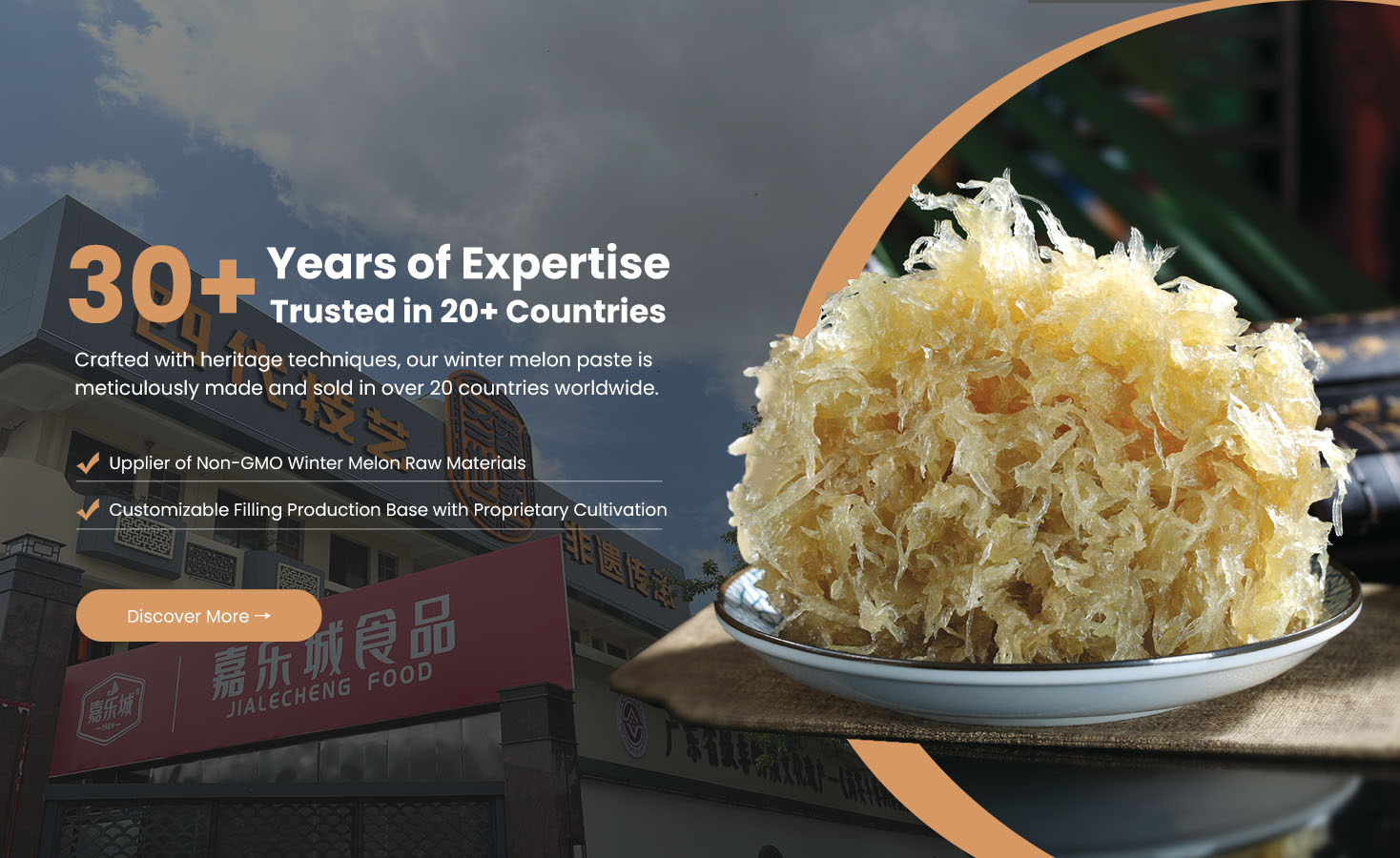What Ingredients Are Typically Used In Winter Melon Filling?
Winter Melon Filling—also called white gourd paste—is a classic sweet filling used in Chinese and Southeast Asian pastries such as mooncakes, wife cakes (老婆饼), and pineapple cakes. Its mild sweetness, glossy texture, and chewy bite make it a perfect base for both traditional and modern baked goods.
The recipe is simple but requires precision in proportion and technique to achieve the signature smooth, aromatic consistency. Leading food manufacturers such as Jialecheng Foods use carefully selected ingredients and controlled cooking methods to produce stable, high-quality fillings for industrial bakery applications.
1. Core Ingredients
| Ingredient | Purpose | Description |
|---|---|---|
| Winter Melon (White Gourd) | Main ingredient | Provides natural fiber, mild sweetness, and translucent texture after cooking. The base of the filling. |
| White Sugar | Sweetener & preservative | Adds sweetness and helps remove excess water during cooking, extending shelf life. |
| Maltose or Glucose Syrup | Gloss and elasticity | Gives the paste a glossy sheen and sticky, chewy consistency. Prevents crystallization of sugar. |
| Vegetable Oil or Shortening | Smooth texture | Keeps the filling pliable and moist, preventing dryness after baking. |
| Water | Cooking medium | Dissolves sugar and helps soften the melon flesh during simmering. |
These five ingredients form the foundation of most commercial and handmade Winter Melon Fillings.
2. Optional Additives and Enhancements
To adapt the paste for different products, additional ingredients can be incorporated during or after the cooking process.
| Category | Ingredient | Function |
|---|---|---|
| Flavor Enhancers | Salt (a pinch) | Balances sweetness and enriches flavor depth. |
| Aromatic Oils | Sesame oil, coconut oil | Adds distinct fragrance to match regional tastes. |
| Natural Extracts | Vanilla, pandan, citrus peel | Provides a subtle background aroma. |
| Preservatives | Sorbitol, potassium sorbate (optional in industrial use) | Extends shelf life in commercial production. |
| Color Adjusters | Caramel syrup or malt extract | Deepens the golden hue of the paste. |
Tip: Traditional handmade fillings avoid artificial flavoring; industrial versions may add mild natural extracts for consistent aroma.
3. Flavor Variations
winter melon filling is highly versatile—it absorbs other flavors easily, allowing creative adaptations for regional and seasonal products.
| Variation | Added Ingredient | Flavor Profile | Common Use |
|---|---|---|---|
| Coconut winter melon paste | Shredded coconut or coconut milk | Creamy, tropical aroma | Wife cakes, tropical desserts |
| Pineapple or Mango Paste | Fruit puree or essence | Sweet and tangy | Modern mooncakes, tarts |
| Sesame Paste Blend | Black or white sesame paste | Nutty, roasted flavor | Cantonese pastries |
| Lotus-Winter Melon Mix | Half lotus paste, half melon paste | Smooth, balanced sweetness | Traditional mooncakes |
| Green Tea Paste | Matcha powder | Mild bitterness, herbal aroma | Contemporary mooncakes |
Industrial producers such as Jialecheng Foods often use winter melon as a base material for blending because it:
Has neutral taste for flexible flavoring.
Provides cost efficiency compared to 100% lotus or red bean paste.
Offers better texture retention under baking heat.
4. Ingredient Quality Standards
High-quality winter melon filling depends on the purity and freshness of its ingredients.
| Ingredient | Quality Indicators |
|---|---|
| Winter Melon | Firm, white flesh with no bitterness or green tint. |
| Sugar | Fine granulated, pure white sugar (no impurities). |
| Oil or Fat | Neutral-flavored vegetable oil or shortening with high heat stability. |
| Maltose/Glucose Syrup | Clear, viscous texture for gloss and elasticity. |
| Flavor Additions | Food-grade, natural extracts or roasted nuts for authenticity. |
Producers like Jialecheng Foods source fresh winter melons directly from their own cultivation bases, ensuring consistent quality and safety from farm to factory.
5. Typical Ingredient Ratio (by Weight)
A balanced ratio maintains sweetness, structure, and baking stability:
| Ingredient | Percentage Range |
|---|---|
| Winter melon flesh | 50–60% |
| Sugar | 30–35% |
| Maltose or glucose syrup | 5–10% |
| Vegetable oil or shortening | 3–5% |
| Water | 2–5% |
The final texture depends on controlled moisture evaporation. Industrial versions usually aim for a moisture content of 18–22%, providing a dense yet soft consistency suitable for molding and baking.
6. Key Characteristics of Well-Made Winter Melon Filling
Smooth texture: No fibrous residue or graininess.
Balanced sweetness: Pleasantly sweet but not overpowering.
Glossy appearance: Slight sheen due to maltose and oil.
Non-sticky feel: Doesn’t adhere to hands or packaging.
Stable under heat: Maintains structure during baking.
| Attribute | Indicator |
|---|---|
| Color | Light golden to amber |
| Texture | Pliable, smooth, and cohesive |
| Aroma | Subtle melon sweetness |
| Flavor | Mild, clean, and well-rounded |
7. Conclusion
A classic winter melon filling is made primarily from fresh winter melon, sugar, maltose syrup, and vegetable oil, slowly cooked until thick and translucent. The result is a silky, sweet paste ideal for pastries, mooncakes, and other bakery fillings.
Modern producers such as Jialecheng Foods combine traditional craftsmanship with industrial precision—using natural ingredients, controlled temperature cooking, and vacuum packaging—to create consistent, export-quality winter melon fillings enjoyed in bakeries around the world.




